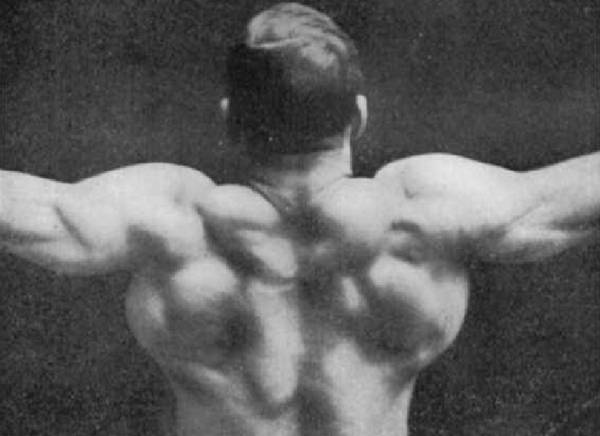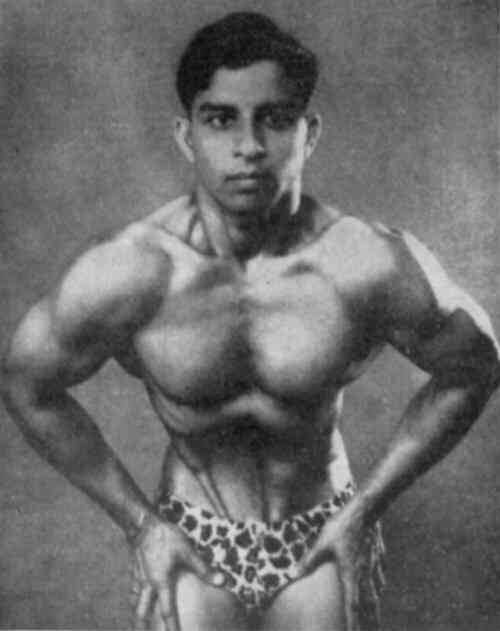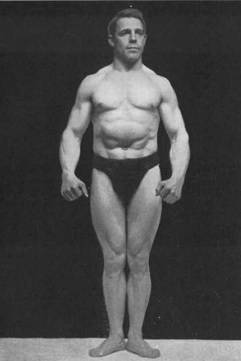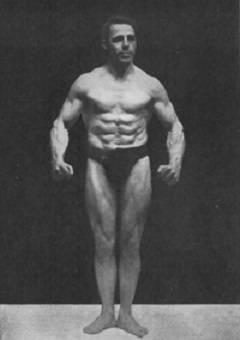Muscle control is for the most part a lost art that is no longer widely applied today. Yet a hundred years ago there was one man whose name was synonymous with it. That man was Maxick (It was originally Max Sick, but that name wasn’t very marketable when you’re teaching health.) Maxick and his business partner, Monte Saldo, claimed their methods of muscle control were superior to any other for health and strength purposes. Were they full of hot air or was it true?
One thing is true for sure. Maxick was a great weight lifter despite not spending much time with weights. He used them to demonstrate his strength, but most of his practice wasn’t with them. He was one of the first to put more than double bodyweight overhead, moving 322.5lbs at a bodyweight of 145lbs. He also performed a strict military press of 222lbs in easy style. In fact, he was so confident in his abilities that he made this challenge:
I will match myself to lift against any man in the world, weight for weight on pure strength lifts. I will even reduce my weight to 9 stone 7 lbs. to meet a man of that weight if he does not care to take advantage of the weight for weight offer. Further I will undertake not to indulge in any exercise with weights or to practice with bars of any description for at least three months before the test if desired by my opponent.
What is Muscle Control?
As defined by Maxick, “To be able by the exercise of will-power to contract certain muscles while relaxing others antagonistic to them is what is meant by muscle control.” If you think about lifting a weight or doing a bodyweight exercise, the movement comes from the action of the muscles. Certain muscles are contracted in groups or isolation, depending on the exercise, which causes the weight to move. There are whole systems built around generating more and more contraction. This practice is useful as that means you will be stronger, but there is a problem in doing it. Maxick explained:
The old-time strong man developed his muscles solely by means of contraction of them. He had an idea that the more he exercised them by contraction, the stronger he must become – oblivious of the fact that his toughened muscles were always being impeded in the work by the antagonism of opposed muscles. Thus, such a man had invariably to expend about twice as much energy as was necessary for the work he had to perform.
Other systems advise using just as much contraction as necessary when doing exercises. This is similar in many respects as to what Maxick said here, although they have different means of getting to this point:
The lifter who applies the science of Muscle-Control to weight-lifting converts that which under old conditions afforded an ugly spectacle into an art beautiful to witness. There is no desperate distortion of the body, caused by general contraction of all the muscles simultaneously, but a series of easy and graceful poses as each set of muscles is brought into operation, while those which are not required are relaxed. The whole strength of the muscles is applied to accomplish the desired end.
How to Practice Muscle Control
 In practicing with muscle control you’re not working on lifting but instead focusing your mind on the contraction and relaxation of muscles. This may sound easier than it actually is.When trying to isolate the contraction in a single muscle, such as the latissimus dorsi, you’ll likely find that other nearby muscles flex as well. Go ahead and try this now. See if you can contract your lats without the pectorals, shoulders, or any other muscles coming into play. Said Maxick:
In practicing with muscle control you’re not working on lifting but instead focusing your mind on the contraction and relaxation of muscles. This may sound easier than it actually is.When trying to isolate the contraction in a single muscle, such as the latissimus dorsi, you’ll likely find that other nearby muscles flex as well. Go ahead and try this now. See if you can contract your lats without the pectorals, shoulders, or any other muscles coming into play. Said Maxick:
It must always be born in mind by the student that muscle-control must be regarded in its widest meaning, which is: to relax, restrain, govern, direct and contract the muscles; not only in groups, but singly as far as the connections and adhesions of the other muscles, tendons, and ligaments permit.
Doing muscle control in isolation is a beginning step. To then take this control and apply it while lifting a weight, sequencing the right muscles for contraction and others for relaxation, will take a lot more time and effort in practicing.
It is probably for this reason that very few people talk about doing muscle control today. Based on the theory of how it works, I can see how it could lead to becoming much stronger. But to get to that point would take dedication of a different kind then what people do in the gym. You wouldn’t hit personal records in lifts but instead may spend hours to improve your isolation of single muscles. The fact is I don’t know of anyone alive today that attributes his or her great strength to muscle control alone. I do know of several people who have performed muscle control in conjunction with other methods, or by itself for a period of time, and gotten positive results.
Although Maxick was the most famous proponent of muscle control, there were many others such as Otto Arco, Eugene Sandow, Edward Aston, and Antone Matysek. Sandow liked to perform muscle control while reading the newspaper in the mornings. He also advocated lifting two-pound dumbbells while using muscle control to apply the real work in the exercises.
Just how far can it be taken? Check out this photo of Professor Chandrashekhar where he has isolated a tendon in his abdomen and one side of his rectus abdominis while performing the abdominal vacuum.

The following are the first two exercises adapted from Maxick’s most popular book, Muscle Control. Rather than the isolation of particular muscles, the idea in these exercises is to train the full body all at once. Thus the first exercise is full body relaxation and the second is a full body contraction.
Full Body Relaxation
 Stand tall and think in turn of each body part from the head down to the toes. Consciously find any tension in any muscle and relax it. Be careful when you relax that you do not accidentally cause any contraction of other muscles in your body.
Stand tall and think in turn of each body part from the head down to the toes. Consciously find any tension in any muscle and relax it. Be careful when you relax that you do not accidentally cause any contraction of other muscles in your body.
Also note that muscles are not absolutely contracted or relaxed but are degrees of one or the other. Thus you can work to get more and more relaxed. While standing, a little bit of tension will be needed to keep yourself erect, otherwise you’d collapse to the floor, but no more than that. Your legs should almost give out under you.
Full Body Contraction
 Once you have attained full body relaxation, contract every muscle all at the same time. You can hold your breath while doing this, but then it should only be maintained for a short time. It can be sustained longer while doing shallow breathing under tension.
Once you have attained full body relaxation, contract every muscle all at the same time. You can hold your breath while doing this, but then it should only be maintained for a short time. It can be sustained longer while doing shallow breathing under tension.
When you do this exercise you may believe that every muscle is contracted, but you’ve likely missed some that are not under proper control. Like with the relaxation exercise, scan your body from head to toe to note any muscles you have missed and contract them. Make sure no other muscles relax while doing this.
An alternative way to practice this exercise is to start in full body relaxation, then starting at the head contract each muscle in turn as you move down the body, being careful to maintain contraction as you move downward.
References:
1. Maxick & Monte Saldo, Health, Strength & Will Power (South Carolina, Strongman Books, 2011), 15.
2. Maxick, Great Strength By Muscle Control (South Carolina, Strongman Books, 2011), 8-9.
3. Maxick, Muscle Control (South Carolina, Strongman Books, 2010), 11, 13, 30-31, 33-38.
4. Bodybuilding Magazine, “Professor J. Chandrashekhar: A Great Muscle Controller” February 1954.






